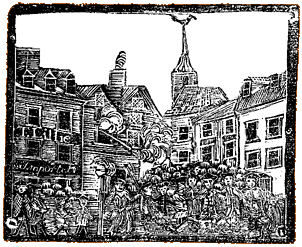The “Swan Shot” that Killed Christopher Seider
 On 22 February 1770, Customs service employee Ebenezer Richardson killed a young boy named Christopher Seider.
On 22 February 1770, Customs service employee Ebenezer Richardson killed a young boy named Christopher Seider.
Christopher was part of a crowd of boys mobbing Richardson’s house. Indeed, he had just stooped to pick up a stone when he was hit by the discharge from Richardson’s gun.
Richardson had not shot a musket ball. Instead, he had loaded his musket with “Swan shot.” What that meant is clear from the Whig newspapers’ report on the boy’s injuries:
soon after the child’s decease his body was opened by Dr. [Joseph] Warren and others and in it were found eleven shot or plugs, about the bigness of large peas; one of which pierced his breast about an inch and one-half above the midriff and passing clear through the lobe of the lungs, lodged in his back.“Swan shot” was a common term at the time. For example, in the 6 Nov 1729 Pennsylvania Gazette Benjamin Franklin reported:
This, three of the surgeons deposed before the Jury of Inquest, was the cause of his death; on which they brought in their verdict, wilful murder by Richardson. The right hand of the boy was cruelly torn, whence it seems to have been across his breast and to have deadened the force of the shot, which might otherwise have pierced the stomach.
We are inform’d that the following Accident lately happen’d at Merion, viz. A Man had order’d his Servant to take some Fowls in from Roost every Night for fear of the Fox: But one Evening hearing them cry, he look’d out and saw, as he thought, a Fox among them; accordingly he took his Gun, charg’d with Swan Shot, and fir’d at him; when to his Surprize it prov’d to be the Servant’s Arm, which taking down the Fowls he had mistaken for a Fox. The Man receiv’d several Shot, some thro’ his Arm, but none of them are thought to be dangerous.In 1751, reporting on how he had knocked himself out with an electric shock, Franklin wrote, “I afterwards found it had rais’d a Swelling there the bigness of half a Swan Shot or pistol Bullet.” Likewise, in Robinson Crusoe, Daniel Defoe had his hero speak of “swan-shot, or small pistol bullets.”
On 22 Aug 1774, a crowd surrounded the house of Daniel Leonard of Taunton, protesting his appointment to the Council under Parliament’s new Massachusetts Government Act. According to Leonard, most people went home but “at 11 o’Clock in the evening a Party fixed upon the house with small arms and run off;...four bullets and some Swan-shot entered the house at the windows.” This is the earliest incident I’ve found of Massachusetts Patriots firing guns in their long political dispute with the royal government and its supporters.
Back in 1770, Richardson’s gun might have contained even smaller pellets than swan shot. During his trial, prosecuting attorney Robert Treat Paine took notes on testimony about George Wilmot, who had helped Richardson defend his house (and was acquitted of murder). If we can read Paine’s handwriting accurately, a witness said: “I took from W[ilmot]. a Gun loaded with 179 Shots. 17. Swan Shot. The rest Goose and Duck.” “Goose shot” and “duck shot” were evidently smaller pellets. Nowadays we’d lump them all together as “birdshot” and assign them numbers.

No comments:
Post a Comment